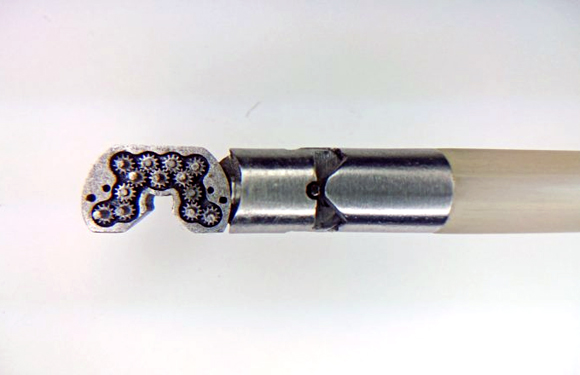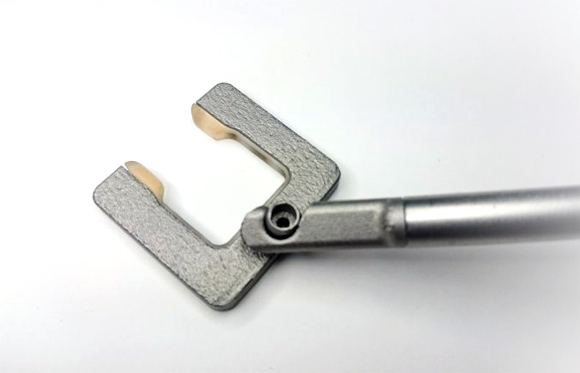New devices produced for cardiovascular surgery using metal Additive Manufacturing
June 16, 2017
Sutrue Ltd, Essex, UK, and the Royal Brompton Hospital, London, UK, have adopted Additive Manufacturing for applications in cardiology by using the technology to develop both a tool which can be used to perform semi-automatic sutures in the operating theatre and a cardiac stabiliser for endoscopic heart operations. The suturing device features metal additively manufactured gears produced using the LaserCUSING process on an Mlab machine by Concept Laser.
Cardiovascular disease is the second most common cause of death in the UK, accounting for 27% of deaths. While drug treatments can deliver minor improvements to patients, in most cases, an operation must be performed. CAD and design development company Sutrue specialises in the development of medical devices for use in cardiology and has recently developed an instrument in which the entire gear mechanism is additively manufactured. The tool, which automatically passes any curved needle, with a suture, through the tissue of a patient, is inserted via a conventional endoscope during cardiovascular operations.
The gear mechanism was developed in collaboration between Sutrue and the Royal Brompton Hospital, and was manufactured by Coherent (formerly ES Technology), Concept Laser’s UK distributor, in Oxfordshire, UK. A precise analysis of the operating method was essential to allow suitable medical instruments to be developed, explained Alex Berry, Sutrue’s Founder: “AM makes it possible to produce geometries that cannot be achieved using traditional manufacturing methods. In addition, the parts have greater performance capacity or functional precision, or else they are extremely delicate or small. This is often precisely what the surgeon was previously lacking.”

Endoscopic suturing head showing additively manufactured gears (Courtesy Coherent)
According to Coherent, the LaserCUSING process offered by Concept Laser is particularly suitable for manufacturing delicate parts where a high level of surface quality is demanded. The system allows a rapid change of material without the risk of any contamination of powder materials. In this case, the machine technology from Concept Laser made it possible to produce the teeth of the gear mechanism, which are each 0.4 mm long.
“In addition to the restrictions on geometry, conventionally milled or cast parts have a few other drawbacks,” continued Berry. “It takes a great deal of time to get to the finished prototype. In addition, the costs are very high. In 3D printing, the parts are produced very quickly and at a fraction of the previous costs of prototyping. But the potential for bionic designs, reproducibility, miniaturisation and not least the reduction in the number of parts and outlay on assembly is also vast. If one looks at the full spectrum of optimising manufacturing and product design coupled with an increase in functionality, 3D printing is capable of revolutionising medical instruments.”

Additively manufactured heart stabiliser (Courtesy Coherent)
The role of a cardiac stabiliser is to keep the heart muscle still at the precise point where the surgeon wants to make an intervention. Richard Trimlett, Consultant at Royal Brompton Hospital, ascertained that this tool needed to be small, dismantlable and designed with exposed channels pre-assembly. Sutrue then developed a biocompatible prototype of the heart stabiliser, incorporating one plastic and one metal part. The finished component, which took three months to finalise, consists of a rod on which the U-shaped heart stabiliser is inserted, like a stamp. The body is metallic, while several plastic suction points allow the tool to affix to the heart muscle by means of a vacuum. To use the tool, the surgeon presses U-shaped head onto the operating site that they want to keep still.
“The solution is estimated to have cost only around £15,000 to develop,” stated Berry. “Comparable conventional developments used to cost upwards of a million pounds.” According to Royal Brompton Hospital, the tool also enables a quicker post-operative recovery for patients. While the average rehabilitation time for a patient is around six months following a conventional surgical intervention, Trimlett states that “Initial experience indicates that patients undergo a demonstrably gentler procedure and can recover after just three to four weeks.”
Trimlett and Berry have stated that their next aim is to use Additive Manufacturing in the production of mechanical pumps that perform the function of the heart, possibly by integrating electromagnetic functions for moving the pump.
















